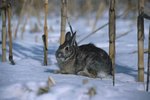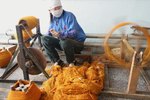
The American mink (Neovison vison) and beaver (Castor Canadensis) are found throughout North America. Both have brown fur coats that are optimal for living near the water, but the similarities stop there. The mink and the beaver are two very different animals with different diets, habitats and personalities.
Location
Both the American mink and the beaver live and thrive throughout most of North America. The American mink lives in 49 states and most of Canada. It doesn’t live in Arizona, nor the Arctic coast or offshore islands of Canada. The mink also lives in the British Isles, where the species made a home after escaping a fur farm in the 1960s.
Like the American mink, the beaver lives and thrives in North America. It is found in parts of northern Mexico, all fifty states and the majority of Canada, but is noticeably absent from some parts of southeastern Massachusetts.
Habitat
The American mink and the beaver are both water-dwelling animals. They live near rivers, lakes, ponds or streams that run along or sit within moist forest areas. The mink prefers areas with plenty of brush and rocky areas for cover. Sometimes, it will dig its own burrow in the land along their water source. Often, it simply crashes the abandoned homes other animals left behind. It lines the inside of its burrow with dried leaves and furs that belonged to its prey.
The beaver loves water as much as the mink. Unlike the mink, it lives in and on top of the water. The beaver gathers twigs, bark, small logs and mud to create its home, called a dam. The bottom of a dam is a mixture of mud and twigs to form a plaster. Logs and twigs are set on top of the plaster to create a dome, which is held together with more mud and leaves. The beaver creates entrances underwater, each leading to a separate enclosed area within the dam.
Appearance
The American mink and the beaver are similar in color. Both are reddish-brown to dark brown. Their fur is also similar, a mixture of long, waterproof strands on top of thicker fur to keep them warm. The similarities in appearance stop there. The American mink’s fur has white patches that stretch from its chin to its chest. Its body is long and thin, and about half of its length is its tail. An American mink has short legs and a triangular face. Its toes are partially webbed for swimming. Females weigh between 1 1/2 and 2 1/2 pounds, while males tip the scale between 2 and 3 1/2 pounds. A mink lives to be about 10 years old.
The beaver is much bigger and more muscular than the mink. The largest rodent native to North America, it weighs between 35 and 80 pounds when fully grown and is between 3 and 4 feet long from head to the tip of the tail. The tail alone ranges from 10 to 18 inches. A beaver’s hind legs are longer than its front legs. It uses the legs and its wide, flat tail to balance when chewing on bark or observing its surroundings. The wide tail and webbed back feet aid the beaver in swimming. A beaver lives about twice as long as a mink.
Food
Food is an important part of the habitat for both the American mink and the beaver. The mink tends to stick to meat in the form of rabbits, mice and other small mammals. In the summer, it will include crayfish, frogs, fish and ducks in its diet.
While the mink is a meat-eater, the beaver is strictly vegetarian. The beaver eats various barks, twigs and leaves. It is especially fond of water lilies and the bark of aspen, birch and willow trees.
Personality
The difference in personality is probably the largest difference between the American mink and the beaver. A mink is a largely solitary animal. Males use an odor secreted from their anal glands to mark territory and especially dislike other males. The mink does not live together with other mink and is a promiscuous creature, mating with various other mink. It mates in the winter. The female gives birth to between one and eight young about two months later. Babies wean within a few weeks and leave their mothers when they are about 10 months old.
The beaver's gestation period and litter is similar to the mink's, but they are otherwise very different animals. The beaver is a monogamous creature, mating with one other beaver for life. It is not solitary and keeps its family unit together for roughly two years. The beaver gives birth after about three months of pregnancy. Typical litter size is four babies, but up to nine is a possibility. Babies wean after a few weeks, but stay with their families until after their second winter. A typical beaver dam includes mother, father, the young from the previous winter and the newborns from the current season.
References
Photo Credits
-
Hemera Technologies/Photos.com/Getty Images
Writer Bio
Leeann Teagno has been writing professionally since 2006. An English major, she continues to study information systems management at American Public University. Teagno is an organic gardener, cook and technology buff with past employment in mobile communications. She also volunteers at an animal shelter and operates a home bakery.



